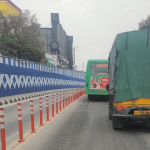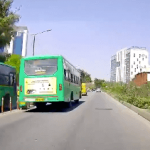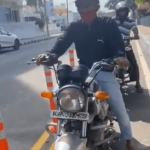By Qamar ZJ
The Bus Priority Lane (BPL) that was put on trial in November last year is being formally launched later this month from Lowry Memorial College to Central Silk Board. However, users on social media have pointed out several flaws in the scheme’s planning and implementation. Some residents call it an ill-thought, stop-gap PR stunt until the 56-km ORR-Airport line of the Metro comes up to ferry people between the airport and Silk Board. We highlight some of the most valid arguments against this lane to give you a ringside view of people’s complaints, suggestions, and pain points.
NOT ALL BUSES USE THE LANE
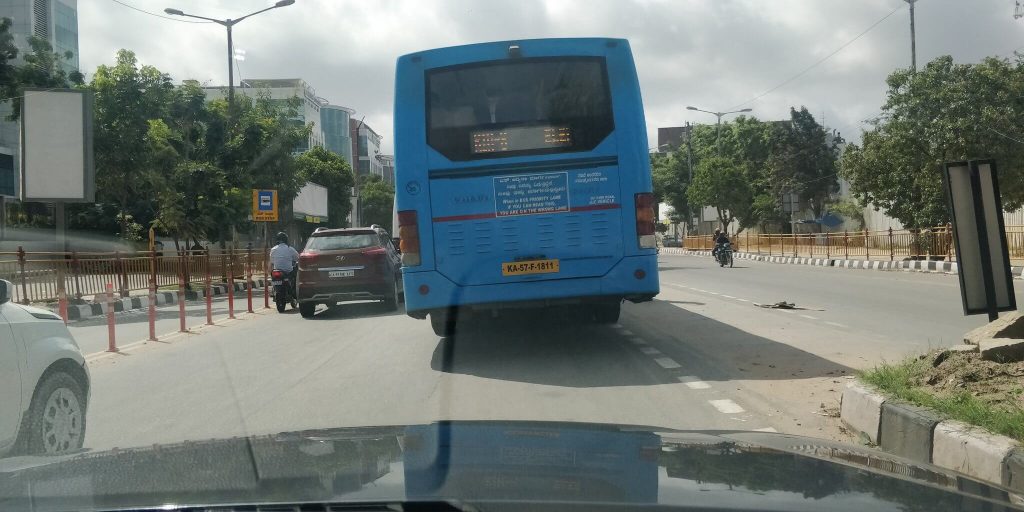
Some commuters are saying that several buses operate outside the priority lane, making the entire exercise useless. Sajiv highlights this issue by posting the picture above. However, some experts suggest that only high-density buses be allowed on this lane, while empty and low-priority buses can take the other lanes.
Light up ORR
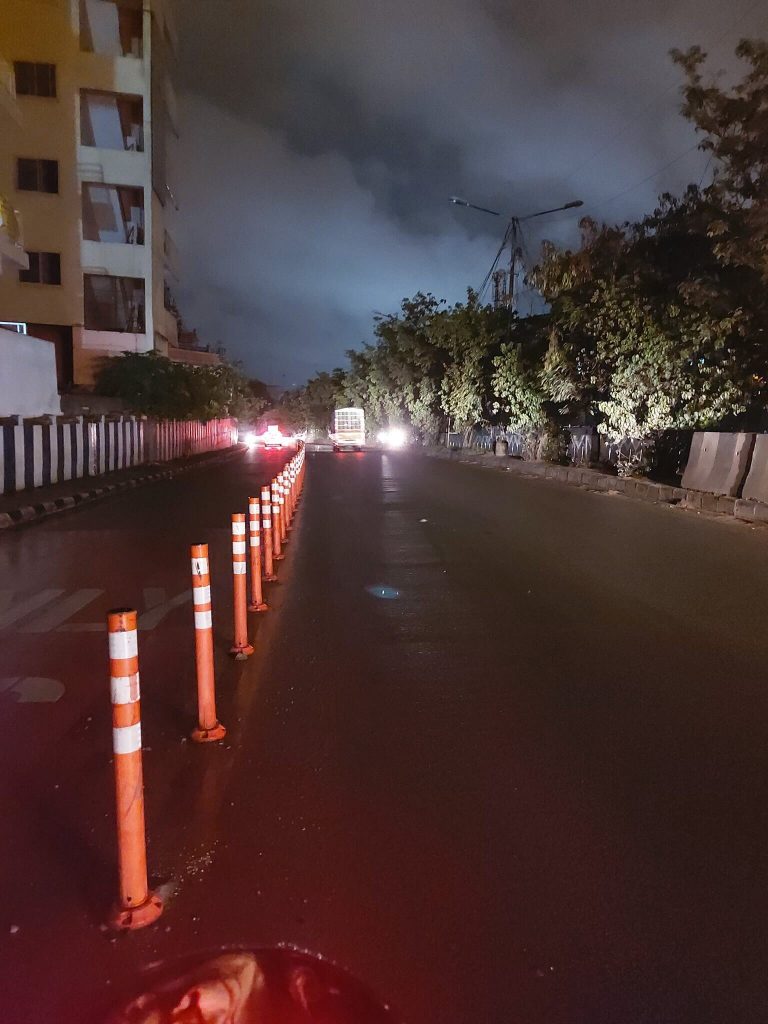
Marathahalli underpass
Residents are also complaining about the lack of streetlighting on crucial check points of the Outer Ring Road, such as the Marathahalli underpass, HSR BDA flyover, or Agara junction. Says Vijayanandan Unni: “Most of the street lights from Silk board to Byappanahalli are not working. The same applies to the stretch from KR Puram to Hebbal and Sarjapur Jakksandra extension.”
BUS BREAKDOWNS IN FAST LANE
Residents are concerned about BMTC buses breaking down in the priority lanes. According to Sateesh TK, the BPL is a really nice idea “so long as a BMTC bus does not breakdown” as “it is a daily affair on the ORR and the bollards have to be removed to make way… that will cause kilometers-long jams. All good now since the traffic is very less on ORR.” Commuters want to know if the authorities will block the entire lane from start to end the plastic bollards in such scenarios.
LAST MILE CONNECTIVITY
The 16-kilometer lane is all fine, but what about connecting the BPL with the residents in various areas surrounding ORR? Residents like Mukesh Inder are asking for “last mile connectivity of 1-2 km where you can take the bus”. Another suggestion is to provide free parking for two-wheelers around bus stops. “They should give it to those holding bus passes, so people can use public transport more efficiently,” says Shivu.
LANE DISCIPLINE
Now that the lane meant for slow-moving vehicles, such as two-wheelers, is moved to the right side of the road, much education and awareness is required to implement the scheme. Says Krishna Sastry: “Provide appropriate guidance to 2-wheeler riders as they are used to the extreme left side of the road, which is now the bus lane!”
ENTRY/EXIT POINTS ARE CHAOTIC
The biggest criticism of this idea is the choke points created at the entry and exit points of the BPL. Says Sumanth: “It is chaotic at the entry/exit points. This can be successful only when there is proper entry and exit to the service road users.”
VEHICLES STOP BEFORE THE BUS STAND
BMTC needs to educate its drivers on proper pick up and drop off routines. The residents are complaining that the bus stands are not being optimally used. Says Nishant: “Why do the bus stop to pick up and drop before the bus stop even though there are no buses or any vehicles near the actual bus stop? At Silk Board, the buses are stopping 100 mtrs before the actual bus stop. Is it so difficult to follow simple instructions?”
NARROWER ORR
Vehicle users are also worried about the constricted road lane on ORR. Experts say that this stretch of the road will take on four-times more traffic due to the constricted space. Trucks, autos, cars, and two-wheelers will all be using this stretch. Once a truck breaks down, which is also quite common on ORR, the entire traffic on the stretch can come to a halt. Says Ravi Garg: “The ORR is not uniformly wide, but uniform width is allocated to BPL. The remaining road is at best only 1.5 lanes wide. Two vehicles can’t move side by side. The changing width of the carriageway and no signage for that will imperil road users even more.”
SUGGESTIONS TO FIX SOME OF THESE PROBLEMS
Bellandur resident and lake activist Nagesh Aras has a slew of ideas to make BPL successful. Some of them include cheaper bus tickets for longer distances, discounts for the underprivileged, a single smart card for hasslefree public transport, responsive scheduling of buses to cater to the demand, and banning slow-moving vehicles. Besides, he wants the government to stop running almost-empty Volvo contract buses for IT firms, and instead rope them in for public transport. Importantly, he wants the BMTC to continuously talk to the various stakeholders and address their many concerns. He also wants the BMTC to privatise the monitoring of traffic violations, and also reward the public who catch lane offenders on camera.
BMTC’S COURSE CORRECTION SO FAR…
Not that the BMTC is being deaf to the many demands posed by the commuters. The launch of the BPL that was planned for Oct 2 was delayed by a week because the authorities wanted to address the concerns at choke points without proper barricades and signages. The department is also installing 150 close circuit cameras to monitor and penalise lane offenders. They could be installed by the end of December.
EDITORSPEAK
While the bus lane idea is a sensible one, it appears to be done without a holistic thought. While the travel time by a bus will be less than before, what about the last mile connectivity? Are their cycle and two wheeler stands that people can park or take on hire at every bus stop? Have they spoken to car users and asked them what they need to switch to public transport? And if they have, what steps have they taken to resolve their issues? The idea of a bus lane is to prevent car users. If this important section of the crowd is not appeased, then this idea is designed to fail. There should be bus shelters at every stop, and there should be good lighting and clear approach paths all along the route. Besides, BMTC should offer high-speed free Wi-Fi on these buses to ensure that work happens on the go. The BMTC should provide real-time data on bus arrivals at all the bus stops and online. More importantly, BMTC should also spend on publicising the BPL and how it’s helpful for car users. When big firms introduce a product, it only becomes great when they spend billions on advertising, market research and focus groups. A similar approach needs to happen with BMTC. They need to make bus travel attractive and irresistible. Ultimately, they have to make their system both flexible and accessible. Only then can real change happen. Greater ridership can only be possible if it’s more integrated with other modes of transport, such as the Metro, and the last mile connectivity options, such as two-wheelers and cycles. What about the six-car ORR-Airport Metro line, you ask? Well, BPL can supplement this service, because a multi-model public transport makes the scenario more resilient and efficient.
